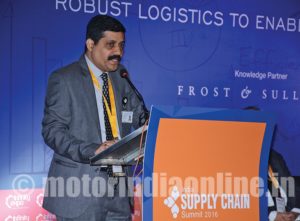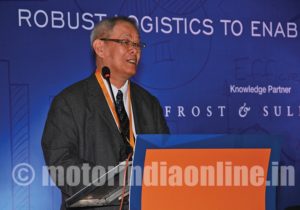Marketing creates demand, while the supply chain fulfills demand. Today, with growing goods and service management, it is time to speak about supply chain and the importance of logistics in a holistic manner. Keeping this in mind, Team Infinity recently organised the ‘India Supply Chain Summit 2016’ in Mumbai. The event tried to identify growth opportunities and learn strategies from evolved companies while stressing the need to adopt best business practices.

Addressing the first session, Manish Panchal, Practice Head, SCM, Tata Strategic Management Group, said: “The economics of supply chain is changing rapidly and will suit the strongest and the fittest. Sir Herbert Spencer, after reading the Darwin theory, had coined the phrase ‘survival of the fittest’, which is turning out to be true in today’s times.”
He drew attention to the four changing levers that could transform the supply chain logistics in India. First will be policy changes like GST along with 100 per cent FDI in rail and shipping. Second change that will boost road transport is the dedicated freight corridors like the Delhi-Mumbai-approximately 1,500 km and Eastern corridor from Ludhiana to Kolkatta approximately 1,900 km. The third and fourth change are embracing technology and enhancing Integration of Information, communication and technology.
All the integration and supply chain vertical is useless if the end result or even the entire process is not sustainable. Shashi Shekhar, Chairman, Supply Chain Logistics Group, UAE, said: “Today we live in adversity in most of the countries. Somewhere there is a lot of water, whereas in some places there is no clean drinking water. The same is with food. A lot of sustainable, long-term integration is needed to bridge the gap between the adversities.”
Growing dependence on technology also generates valuable data. Harish Pant, Managing Director, Hampson Industries, opined that “big data in logistics will help predict supply chain demand that could uplift the last-mile connectivity.” He also pointed at the 3D printing technology that can be a big game changer as it may enable printing of small spare parts needed for production at a nearby location to the factory.
Supply chain bottlenecks
Speaking about the bottlenecks in supply chain today, L. Badrinarayan, Partner, Lakshmikumaran & Sridharan, said: “Today tax consideration overrides ‘time to market’ instead of ‘cost to market’. There are multiple rates and a lot exemption under VAT. Small warehouses across States in India lead to minimum or no automation. Adding to the woe are inter-State borders and unorganized industries.”

Introduction of GST is believed to ease a few things. He added: “GST will certainly bring agility in the supply chain and add in the direction to keep uniform rates across India. However, to expect that all check-post will go away is actually too much to expect. “They would be required to understand the vehicle maintenance and composition. We could but expect one uni-directional check-post, instead of two on each State border,” averred Badrinarayan.
How China ‘Made’ it?
Before India started the ‘Make in India’ initiative it was ‘Made in China’ that caught the world’s attention. But how did China achieve this? Adam Mo, Sales and Marketing Department General Manager, Zhuhai Founder PCB Development Co. Ltd., said: “Chinese factories and people up the ante by hi-tech manufacturing along with smart entrepreneurs, know-how and infrastructure. This became a durable advantage over the years.”
Today China’s competitive advantages are:
* A high national saving rate in the mid-40s.
* China is self-sufficient in capital and not dependent on foreign direct investment to maintain its high rate of investment.
* An almost unlimited supply of labour – almost 40 per cent of labour is in the primary sectors like agriculture and mining – produces almost 12 per cent of GDP.
* There is less upward pressure on the real wage rate of unskilled entry-level labour for decades to come.
* A large domestic market permits realization of economic of scales.

Owing to these points and low salaries of people, high investment in port, road and rail infrastructure, solid engineering with technical skills and a strong supply chain base made China the largest producer of manufactured goods. Apart from exports, the inward growth because of a vast domestic market, just like India, fuelled China’s astonishing emergence as a world manufacturing powerhouse.
Growth drivers for ‘Make in India’
While ‘Make in India’ has given a new lease of life to the Indian manufacturing industry, like ‘Make in China’ did four-five decades ago, the Indian supply chain and logistics industry will evolve. So what is the India way? The organisers had listed a few possible growth drivers that will lead to India growing both internally and externally.
A glimpse into those industrial sectors highlights the anticipated upsurge in trade and commerce and the consequent growth in the need for a strong logistics industry:
- India’s nominal GDP is expected to grow to $3.6 trillion by 2020
- By 2030, India’s crude steel production is expected to increase by a factor of 4.
- Demand for cement in the country is expected to double by 2030.
- Agricultural output, although reduced in size as a percentage of the economy, is expected to increase from 207 million metric tonnes (MMT) to 295 MMT by 2020.
- The Indian textiles industry is expected to triple from $78 billion currently to $220 billion by 2020.
- The share of organized retail is expected to increase from the current five per cent to 24 per cent by 2020.
- India’s industrial energy consumption is expected to double by 2020. In this scenario, the country will need to mine two billion tonnes of coal by 2030 and transport 75 per cent of mined coal. Further, around 30 per cent of the total transported coal will have to be imported through ports.
- Overall export-import cargo at Indian ports is projected to increase to around 2,800 MMT by 2020 from the current approximately 890 MMT.
- Finished consumer goods, both imported and those produced in India, will have to be transported to the country’s middle-class consumers, which, by 2030, are expected to increase fourfold from the current middle class population of 160 million.
Thus, to sustain and drive economic growth, movement of goods associated with a mature economy will require a vastly superior service sector as well as physical logistics infrastructure.

Learning from slowdown
Adam Mo also touched upon the slowdown in China which is the ‘near-shoring’. “It is the practice of producing closer to the customer to meet the ‘end market demand’. “The world is in the middle of transformation where companies are moving from a global manufacturing strategy whose focus is on low-cost countries to a more regional strategy,” revealed Mo. However, China’s manufacturing is thriving despite rapidly rising wages as some low-cost manufacturing activity is living the country but that work is more often taken by countries in south-east Asia. “China’s share for American shoe imports slipped from 87 per cent in 2009 to 79 per cent in 2015, but it was Vietnam, Indonesia and Cambodia that picked up all nearly all of that lost production in China,” explained Mo with an example.
In another example, he emphasized how companies like Samsung, Microsoft, Toyota and other multinational firms are trimming their production in China and are turning to places such as Myanmar and Philippines to reinforce a regional supply chain with China at the centre.
Professor Lai Ving Kam, Head of Programme – Logistics and Supply Chain Management, Berjaya University College, Malaysia, too shared similar views as Mo. “Companies that managed to be efficient during recession show remarkable performance outperform the competitors and gain additional market when the economy revives.”
It was evident from both the foreign speakers that India should keep in mind the lessons from China and even Malaysia, to enhance competitive position, focus on core business and strategically think of ways to reduce cost. If possible India should think about its stand also on China’s ‘One Belt One Road (OBOR)’ project that opens up huge supply chain pathways. “The OBOR is set to result in greater diversification especially as China has repeatedly indicated that the route is not fixed yet and all countries, including India, Japan and Russia, are welcome to join the silk road plans,” concluded Mo.